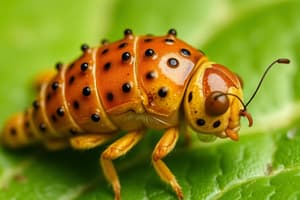Podcast
Questions and Answers
What is movement in living organisms?
What is movement in living organisms?
An action by an organism or part of an organism causing a change of position or place.
What is respiration?
What is respiration?
The chemical reactions in cells that break down nutrient molecules and release energy for metabolism.
Define sensitivity in living organisms.
Define sensitivity in living organisms.
The ability to detect or respond to changes in the internal and external environment.
What does growth mean in the context of living organisms?
What does growth mean in the context of living organisms?
What is excretion?
What is excretion?
What does the term nutrition refer to in biology?
What does the term nutrition refer to in biology?
How is a species defined?
How is a species defined?
What is the binomial nomenclature system?
What is the binomial nomenclature system?
What do classification systems aim to reflect?
What do classification systems aim to reflect?
How are close evolutionary relationships determined in organisms?
How are close evolutionary relationships determined in organisms?
What is a dichotomous key used for?
What is a dichotomous key used for?
What is the first division of living things in the classification system?
What is the first division of living things in the classification system?
Flashcards are hidden until you start studying
Study Notes
Characteristics of Living Organisms
- Movement: Living organisms can change position or place; single-celled organisms and animals move as a whole, while fungi and plants can move parts of their body.
- Respiration: Involves chemical reactions that break down nutrients to release energy, typically requiring oxygen.
- Sensitivity: The ability to detect changes in internal and external environments.
- Growth: Characterized by a permanent increase in size and dry mass, observable in unicellular organisms and complex multicellular organisms.
- Reproduction: Processes that produce more organisms of the same kind; includes binary fission in unicellular organisms and sexual/asexual reproduction in multicellular organisms.
- Excretion: The removal of waste products formed during metabolism, such as carbon dioxide, through various means of expulsion.
- Nutrition: The intake of materials necessary for energy, growth, and development; plants (autotrophs) absorb light, while animals (heterotrophs) consume organic materials.
Classification of Organisms
- Species Definition: A species is a group of organisms capable of producing fertile offspring.
- Binomial Nomenclature: An internationally recognized system for naming species, consisting of two parts representing genus and species.
- Classification Hierarchy: Organisms are grouped into Kingdom, Phylum, Class, Order, Family, Genus, and Species, focusing on unchanging traits that differentiate them.
- Evolutionary Relationships: Classification reflects phylogenetic connections, indicating organisms with shared features likely descended from common ancestors.
Conservation and Identification
- Conservation Efforts: Understanding diversity among organisms supports habitat management and breeding programs.
- Common Ancestry: Organisms with numerous shared traits are typically more closely related, suggesting more recent common ancestry.
- Historical Grouping: Previous systems relied mainly on morphology and anatomy for classification due to observable characteristics.
DNA as a Classification Tool
- DNA Sequences: Closely related organisms exhibit similar DNA base sequences due to fewer mutations over evolutionary time.
- Importance of Similarity: The more closely related two organisms are, the more similar their DNA sequences, indicating recent common ancestry.
Practical Applications
- Dichotomous Keys: Simple classification tools based on identifiable features that help organize organisms.
- Five Kingdoms of Life: Initial classification divides all organisms into five kingdoms: Animals, Plants, Fungi, Protists, and Monera.
Studying That Suits You
Use AI to generate personalized quizzes and flashcards to suit your learning preferences.




